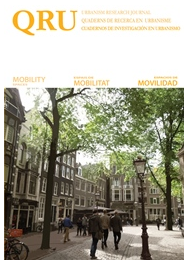La trama del peatón sobre la trama urbana: la impronta de las lógicas internas del desplazamiento a pie en la cualificación de los ámbitos urbano
DOI:
https://doi.org/10.5821/qru.9601Abstract
What does movement on foot mean in current complex large cities? Many cities all over the world have tackled the issue of reclaiming more footpaths, facing vehicular mobility abuse. How do they do it? What strategies do they use? To what extent are they able to transform road schemes and urban structures resulting from the long-term application of a speed and efficiency paradigm? How limited is the negotiation among types of mobility within the city? To what extent does it make sense to pedestrians? This “regeneration” has added “higher quality” public space to streets; the capillary network of mobility supposedly distributes such public space throughout the city in a more uniform array. Is this a possibility or do pedestrian zones generate privileges and isolated hierarchies? Finally, it is worth asking if the special interventions for pedestrians are copying the internal logics of those who walk, to give sense to these places where there are inserted.Downloads
Issue
Section
License
Those authors who have publications with this journal, accept the following terms:
a. Authors will retain their copyright and guarantee the journal the right of first publication of their work, which will be simultaneously subject to the Creative Commons CC BY-NC-ND-4.0 recognition license that allows third parties to share the work provided that its author and its first publication are indicated in this journal, but they cannot be changed or used commercially.
b. Authors may adopt other non-exclusive license agreements for the distribution of the version of the published work (eg: deposit it in an institutional telematic archive or publish it in a monographic volume) provided that the initial publication in this journal is indicated.
c. Authors are allowed and recommended to disseminate their work through the Internet (e.g. in institutional telematic files or on their website) before and during the submission process, which can lead to interesting exchanges and increase citations. of the published work. (See The effect of open access).













